Film, TV Production Begin to Emerge in Unknown Territory

O.K., we’ve had it!
We’ve watched all the “new” movies (that we really thought were worthwhile), we’ve scanned “the trades” and discovered there is nothing coming out of the pipeline until … a vague “soon.”
We knew that.
We can call folks who work on projects and either answer their phone or call back in less than 30 minutes.
Normally, they’re busy on location, in the audio/video postproduction facility or whatever … working.
It could be days before they poke their head up.
To get an idea of when we can inhale again, we touched base with one of the money people we know, Aaron Semmel, CEO of BoomBoom Booya, [email protected]. Aaron is an executive producer – a title that can be as broad or narrow as the director, studio/project owner and the individual’s experience chose to make it.
Suddenly, people with his experience and focus are really, really important to the M&E industry.
 We first met him a few years ago at an HPA (Hollywood Professional Association) and creative storage conference and discovered EP isn’t just a nice title that appears at the end of a movie along with the rest of the scrolling credits.
We first met him a few years ago at an HPA (Hollywood Professional Association) and creative storage conference and discovered EP isn’t just a nice title that appears at the end of a movie along with the rest of the scrolling credits.
Since money greases the industry’s wheels, we figured he and other EPs would be a good bellwether as to what production is going to be like when we get out of this tunnel.
In other words, when will folks be back to work and what will the new work look like?
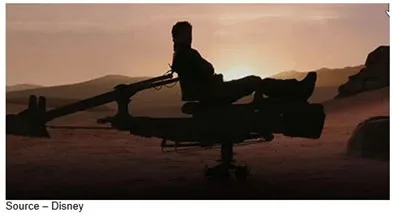
The quick answers … soon, different.
“In two months, the ground rules for the industry have changed dramatically,” Semmel said. “There were hundreds, thousands of film/TV projects in various stages of production around the globe abruptly put on hiatus.
“The fortunate projects were those that had wrapped production and had moved to post,” he continued. “They could do the work remotely and in isolation, moving content from audio/video specialists in the cloud and barely miss a beat. A number of these projects are complete or near completion, so they’ll be appearing when the time is right.
“The rest of us basically have to take a hard look at everything – including financial and time budgets – as though it’s a new project because all of the rules have changed,” he added. “It’s what every producer, studio and EP we know, including myself, are doing right now.”
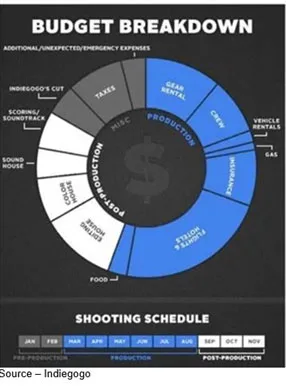 One of the first budget items to change will probably be travel because global travel and location selection will be sharply limited.
One of the first budget items to change will probably be travel because global travel and location selection will be sharply limited.
The days of actors and crews moving from exotic location to exotic location to take advantage of generous tax subsidies will be curtailed if not off the table.
According to film industry analyst Stephen Fellows, just under two-thirds of the films shoot in one country, 23 percent in two and 12 percent in three or more countries.
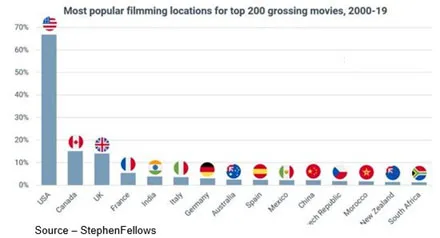
While states and cities across the U.S. have been popular shooting destinations, they have faded in recent years with Canada becoming the home away from home.
But the rapid construction of large studio facilities, skilled crews and a vaguely familiar language have proven to make the UK an attractive option. True, the generous tax rebates and falling Pound probably also helped in the decision process, but that could change.

The eerie silence of Hollywood’s studios and backlots could quickly disappear when production opens up again as studios and producers determine it is safer – and faster – to keep the work closer to home.
While the pandemic shift could give a lift to American shooters and tradespersons, the losses to other countries’ economies will probably be offset by the increase in local creation by streaming content services that have agreed to produce at least 30 percent of the work locally.
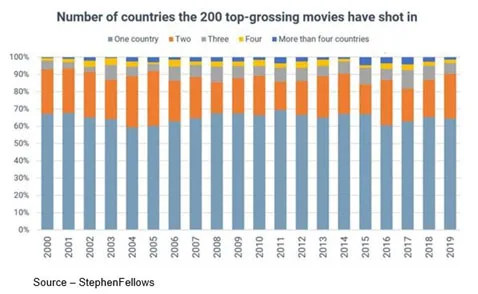
In other words, it could have been better had the world and industry stayed the course, but it isn’t all bad.
Of course, for the streaming consumer it’s all good because they’ll be able to enjoy an even richer breadth of visual stories from around the globe.
And with dubbing and subtitling becoming faster/easier and more economic, we’ll all have a world of content quickly and economically available on our screens … cool!
Okay, that takes one issue off the table for EPs; but some of line items have taken on new or added degrees of import.
Some EPs are creatively moving budget items around while others being forced to secure more funding.
Semmel noted that he and others are also taking advantage of advances like real time VFX, VR and LED walls. Especially beneficial for large productions (think Gravity), they enable the project crew to carry out everything on a single sound stage.
“These new tools provide a more controlled environment, which means a more safe, secure creative space — which everyone wants and needs today,” he explained. “They also help us more easily meet the bonding and insurance requirements and stay on budget (time and money).”
In other words, because of the new guidelines and requirements, EPs have become more involved members in the total project process.
Netflix has already re-started production in South Korea, Iceland and Sweden, where each country has its own set of protocols in place ranging from immediate testing to voluntary quarantine prior to production.
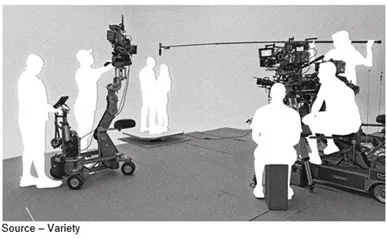
Not long-ago, Los Angeles County estimated that about 890,000 film/entertainment folks weren’t working and the studios wanted/needed them on the set.
In addition, the industry has to qualify and add COVID coordinators and health/safety team members.
The new protocols and job descriptions (which are still a work in progress) can result in the addition of 10-15 personnel plus cleaning/sanitation equipment and as much as $1M plus to mid-level projects.
It means production work will be slower and shoots will go longer because crew shifts will have to be staggered to minimize the number of “essential” people on the set … negatively impacting the project budget.
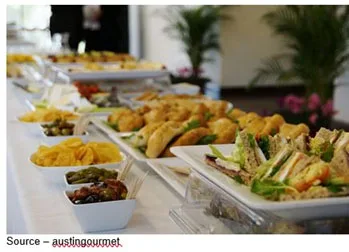
The fantastic cafeteria-style craft service meal has already been replaced with single-serving pre-wrapped meals and single-use utensils.
Lunch/dinner breaks for the crew will be staggered and people will have to practice better than social distancing, which will certainly cut down on set rumors, etc. That will help everyone stay on their diet, but we were sad to hear the fist-dippin’ bowls of peanuts and M&Ms were retired.
But we guess if it means keeping everyone on the set healthy and the project on budget, it’s a small sacrifice.
The biggest challenge (question mark) for studios, directors and EPs will be the innocent-looking line item … insurance.
No insurance, no bonding.
No bonding, no funding.
No funding, no budget.
No budget, no project.
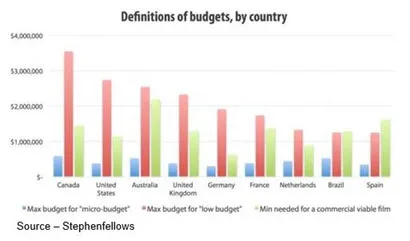
It doesn’t matter if it is a nano-, micro-, low, medium- or holy crap budget; nothing gets done until the ink is dry on the insurance policy.
And that, according to Semmel and other EPs we’ve talked with, is the unanswered question for studios, diectors, producers and the entire cast/crew.
Policies used to be pretty cookie cutter back in the old days (pre-2019). People had a cold, someone blew up a couple of cameras, a few vehicles were burned to a crisp, stuntperson broke a limb/got a concussion, city street signs were burned, bystander windows were blown out or someone died on set … all were covered.
The standard “business interruption” clauses were included and the actuarial data was known at the time of the insurance writing based on locations, story flow, risk factors, schedule recovery time and even gambling odds of the gotcha occurring.
Things like “acts of God” or natural disasters were included (at a hefty cost) or were excluded and the studio/producer/production company moved forward and held their collective breath.
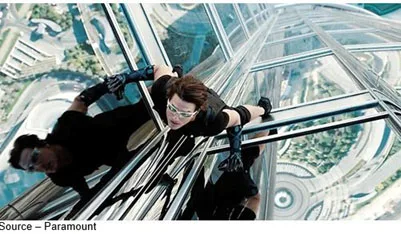
If producers or actors wanted a stunt added such as Tom Cruise scaling the Burj Khalifa the tallest building in the world himself in Mission: Impossible – Ghost Protocol, the insurance company could accept the risk or … be replaced.
The insurance company was fired, someone else underwrote the $500M policy and yes, they probably changed their pants when the shoot was completed.
But as film and TV production slowly begins to emerge, insurance against an unknown/unseen illness/pandemic-related shutdown will be difficult to assess, calculate and monetize.
No one saw or even imagined in their worst-case scenario that something like COVID-protection would be, will be needed.
If pandemic-insurance coverage can be found/written, it won’t be cheap!
As an alternative, studios, producers and production companies will emerge from hibernation and choose a single “manageable” location with everyone, everything confined in the same ecosystem for the duration of the production.
“Since we don’t have a viable/proven vaccine, everyone understands there is a certain degree of risk involved and it’s everyone’s job to manage that risk as much as possible,” said Semmel.
It will be the studio’s, production company’s onus to provide and maintain a safe project workspace – taking temperatures, sending folks home with symptoms, providing masks/gloves for crew behind the scenes and constant cleaning/sanitization.
Beyond that, everyone involved will have to sign a rider – similar to present behavior code riders.
A draft rider we recently saw was simply stated (which means it probably won’t survive the lawyers) — “You acknowledge you are going into a high-density area, and while we will do our best effort to protect you, nothing is failsafe and if you contract COVID-19, we are not liable.”
Folks don’t have to sign it of course, but the person behind them probably will.
Requirements/insurance will be tailored to meet the individual country’s guidelines; and remember, these items have to be considered even before there’s a budget and bond.
It ain’t gonna be fun, it ain’t gonna be easy.
And yes, it will suck a lot of the fun out of creating tomorrow’s video story.
A deep-thinking indie filmmaker summed it up best for us recently, “It costs what it costs and takes what it takes.”
As Semmel noted, “We’re moving into a different era but there are still a lot of great stories to be written, shot, produced, edited and offered up to a very hungry entertainment audience.
“Just as important is the fact that there’s a lot of very good content creation people ready, willing, able and anxious to get back to work,” he added. “Me included!”
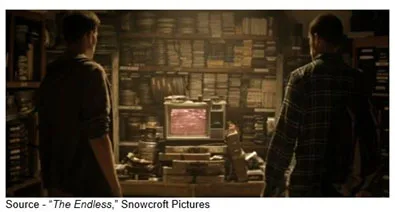 As an unknown in The Endless said, “We never anticipate the ways we’re gonna isolate ourselves from the ones we care about.”
As an unknown in The Endless said, “We never anticipate the ways we’re gonna isolate ourselves from the ones we care about.”
# # #
Andy Marken – [email protected] – is an author of more than 600 articles on management, marketing, communications and industry trends in media & entertainment, as well as consumer electronics, software and applications. An internationally recognized marketing/communications consultant with a broad range of technical and industry expertise in storage, storage management and film/video production fields; he has an extended range of relationships with business, industry trade press, online media and industry analysts/consultants.